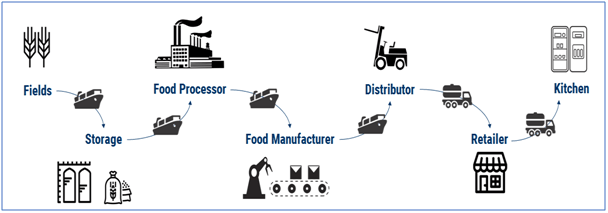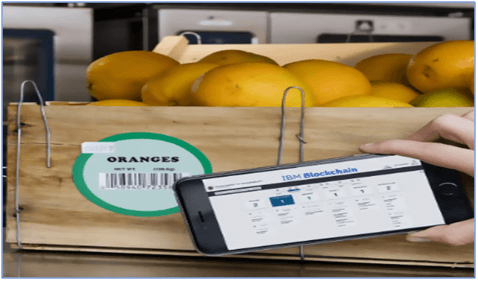Growing world populations are expected to reach 10billion by the year 2050. With this, we are also expected to demand on the food supply chain to evolve and become more efficient, more accurate and more reliable. More and more people want visibility into what’s inside the products they are about to consume. They want to be able to make trustworthy food choices for themselves, their families, and their communities.
The complexity of the global food supply chain can be shown in the diagram below.

The increasing distances the food is traveling, from producer to consumer, keeping the food safe and at good quality is a big challenge the supply chain is facing. In one of the recent food scandal, in March 2018, an outbreak of Escherichia coli (E. coli) which was found in romaine lettuce had taken 1 life and caused 149 sick people in the United State. The hidden nature of foodborne illness symptoms only makes it more difficult to deduce exactly where a contaminated product originated.
The low transparency in the supply chain and inefficient batch sorting are the cause of lack of traceability. With Blockchain technology and the cooperation of the many members of a food supply chain, a single product can now be tracked in literally 2.2 seconds. This speed is now possible and helps improve the transparency and management of the food supply chain which will help establish that trust for the consumer.
Table of Contents
Key Features of Blockchain
1. A Blockchain record cannot be controlled by a single entity
It needs to take control of more than 51% of all the networked computers controlling the Blockchain to amend the record. From a single computer, a request to add can only be processed, and also to view the current Blockchain record. This creates a clearer audit trail and consistency across parties.
2. Information recorded is shared by a large number of entities
If one computer is corrupted for some reason and is offline, the other computers in the Blockchain network will still maintain the Blockchain record. Each computer in the Blockchain network will have a copy of the Blockchain record. This ensures that no matter what happens, there is a build in fail-safe in information records, be it man-made or natural equipment failures. This useful feature becomes critical if your supply chain system is connected worldwide, having a decentralized data system like Blockchain technology will make it robust to any centralized system failures, making information recovery swift ensuring continuous supply chain operations and almost impossible to hack.
3. Information recorded in a Blockchain cannot be corrupted
The programmed protocol of a Blockchain record does not allow for modification of entries already added previously. Blockchain technology ensures information integrity which is tamper-proof to a higher degree. This comes useful for supply chain information systems that are reliant on corrupt proof information at all nodes of the supply chain system.
Blockchain for the Food Industry
1. Preventing Foodborne Outbreaks, Enabling Fresher Goods
IBM has teamed up with several major suppliers including Wal-Mart, Dole, and Nestle to come up with a blockchain-powered system that can be used to track a product’s journey from farm to store shelves. The goal is to create a more transparent deployment and transportation process. Blockchain can help identify problematic systems and processes, hopefully cutting down on the risk of contamination in the future. Suppliers and retailers can use blockchain to keep food fresh. This is especially important since the FDA Food Safety Modernization Act (FSMA) calls for reliable hygiene and storage methods during transportation.
2. More Accurate Inventory Tracking
Sudden shortages pose significant challenges to the food supply chain. A variety of external factors contribute to a supply block, including inclement weather, poor soil, insect infestations and much more. Through the use of blockchain, the supplier can know exactly how much supply is available and what they need to do to ramp up their offerings.
3. Real-Time Tracking
Food companies can attach connected IoT tags to shipments, with each shipment assigned a unique identification number. These IDs will be tied to products’ origins, processing data, storage temperatures, expiration dates, and other information. At each stage in the supply chain, employees can simply “check in” the product using its ID number, and the blockchain will securely track the product over time across checkpoints. Wal-Mart, one of the US’s largest food retailers, has been somewhat of a pioneer in using blockchain to support food safety.
4. Consumer Payments
Crypto-currencies have the potential to solve some real problems in the consumer financial world. The transaction costs of being outside that system can be very high, especially when you’re talking about immigrants sending money back home. High transaction costs constrain a market. That’s basic economics in the sense that a high price for a good or service depresses demand for the good or service.

Picture taken from: https://qz.com/1060607/supermarkets-are-now-using-blockchain-to-keep-food-fresh/
Visibility and Building Consumer Confidence
1. Product Trail Records
Blockchain technology enables one to track how the product gets from the supplier to the producer, and how it is distributed. It is possible to get information about the origin and destination of the product. The buyer gets full knowledge about the origin of the product, its delivery time, and additional facts about its consumption.
The full content is only visible to SIPMM members
Already a member? Please Login to continue reading.
References
Chase Purdy. (2017). “Supermarkets are now using blockchain to keep food fresh”. Retrieved from https://qz.com/1060607/supermarkets-are-now-using-blockchain-to-keep-food-fresh, accessed 20/03/2019.
Kirsten Salyer. (2018). “Food Trust partnership uses blockchain to increase food safety”. Retrieved from https://news.itu.int/food-trust-blockchain-food-safety,accessed 20/03/2019.
Sam Mire. (2018). “Blockchain In Supply Chain Management: 13 Possible Use Cases”. Retrieved from https://www.disruptordaily.com/blockchain-use-cases-supply-chain-management/, accessed 16/03/2019.
Samantha Redocchai. (2018). “3 Innovative Ways Blockchain Will Build Trust In The Food Industry” Retrieved from https://www.forbes.com/sites/samantharadocchia/2018/04/26/3-innovative-ways-blockchain-will-build-trust-in-the-food-industry/#688db7652afc, accessed 17/03/2019.
Srinivasan Varadarajulu, ADPSM. (2018). “Blockchain Technology Enabling Seamless Supply Chain”. Retrieved from SIPMM: https://publication.sipmm.edu.sg/blockchain-technology-enabling-seamless-supply-chain, accessed 18/03/2019.
Tea Min Lye, GDSCM. (2019). “Five Applications of Blockchain Technology for a Digital Supply Chain”. Retrieved from SIPMM: https://publication.sipmm.edu.sg/five-applications-blockchain-technology-digital-supply-chain, accessed 18/03/2019.
Research (2017). “How Blockchain Could Transform Food Safety”. Retrieved from https://www.cbinsights.com/research/blockchain-grocery-supply-chain, accessed 20/03/2019.

